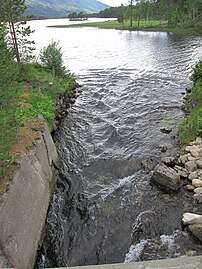Lesjaskogsvatnet
| Lesjaskogsvatnet | |
|---|---|
Rauma | |
| Catchment area | 45.65 km2 (17.63 sq mi) |
| Basin countries | Norway |
| Max. length | 10 kilometres (6.2 mi) |
| Max. width | 1 kilometre (0.62 mi) |
| Surface area | 4.3362 km2 (1.6742 sq mi) |
| Surface elevation | 611 metres (2,005 ft) |
| Settlements | Lesjaverk, Lesjaskog |
| References | NVE[1] |
Lesjaskogsvatnet (literally: the
The lake is unusual by having two outlets, one in each end. It flows east into the
The lake was
Norwegian campaign 1940
No. 263 Squadron RAF operated with 18 Gloster Gladiator biplane fighters from a landing strip on the frozen Lesjaskogsvatnet in late April 1940 as part of the Norwegian campaign.[8]
The British air force chose Lesjaskogsvatnet because of the relatively short distance to the front line in the Gudbrandsdalen Valley as well as proximity to the British base at Åndalsnes. The British also planned to bring in large amounts of explosives from Scotland to blow up the railway tunnels at Dombås (this would block railway connections to Åndalsnes and Trondheim), but the German forces advanced too fast. The ice was covered by at least 40 centimetres (16 in) of snow and a few hundred locals cleared a 750-metre (2,460 ft) long and 70-metre (230 ft) wide runway. Snow clearing began on April 20 and the same day Norwegian Fokker C.V surveillance planes landed with skis. The workers on the ice were attacked by German fighter planes, and most snow clearing was then done during night. Some 100 ground crew arrived on April 23. The runway was used on April 24 and the 18 planes completed about 40 flights and attacked 37 enemy planes. That same night was extremely cold and engines did not start. Early morning April 25 the makeshift airfield was attacked by Heinkel He 111s and Junkers Ju 88s. Two British plane that were unharmed but unable to fly were burned by the crew. At the end only five planes survived and were moved to Setnesmoen camp at Veblungsnes on April 26.[9][10]
Media gallery
-
Outflow to Rauma and dam
-
Bridge at Bryggeosen, outflow from eastern to western part of the lake
-
Lågen outflow at Lesjaverk
-
Eastern part at Bryggeosen
See also
- List of lakes in Norway
References
- ^ nve.no(in Norwegian). Retrieved 7 April 2022.
- Store norske leksikon(in Norwegian). Retrieved 19 January 2017.
- ^ Stagg, Frank Noel (1956). East Norway and its Frontier. George Allen & Unwin, Ltd. Retrieved 19 April 2009.
East Norway and its frontier By Frank Noel Stagg.
- ^ Kleiven, Ivar (1923). Lesja og Dovre. Kristiania: Aschehoug.
- ^ Petterson, L.E. (2004). Flomsonekartprosjektet Flomberegning for Rauma. Norwegian Water Resources and Energy Directorate.
- ^ "Eksplosivt på isen". NRK (in Norwegian). 26 November 2010. Retrieved 18 January 2017.
- ^ Reusch, Hans (1905). "En eiendommelighed ved Skandinaviens hovedvandskille (A peculiarity of the Scandinavian divide)" (PDF). Norsk Geologisk Tidsskrift. 1 (1): 1–15.
- ISBN 0-312-06427-6.
- ^ Tamelander, Michael; Zetterling, Niklas (2001). 9. april. Nazitysklands invasjon av Norge. Oslo: Spartacus.
- ^ Øystein Mølmen: Krigen 1940-45. Lesjaskog, 1996




